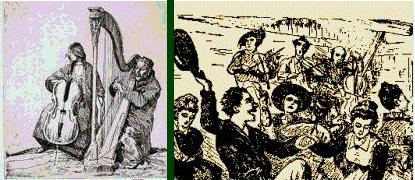Our fearless leader has placed Morrison's jig into a medley that leads into GRYMG, with the guitar player playing bohdran (a type of drum, pronounced bow-ron) instead of guitar. That means my cello will provide the only harmony.
Both tunes are, nominally, in E minor, but that's about where the similarity usually ends. GRYMG, as usually harmonized and performed, is in classical E minor. The melody technically fits the Aeolian mode but traditionally with the 6th and 7th degrees raised or lowered in the harmony lines to enhance harmonic richness and make for interesting alto, tenor, and bass parts .
However, the melody itself has no altered tones. By itself it's just good ol' simple, primitive Aeolian. And that's what you hear with just two dulcimers playing melody with no harmony to "classicalize" it.
Morrison's jig is even more primitive. Our version consists almost entirely of a gapped scale. Of the 100 or so notes, the sixth degree appears only once, and then as a very quick passing tone, and it's raised, ie Dorian mode. However, the sixth degree is so brief that the tune's commitent to Dorian is negligible. The tune is mostly just notes of the E minor chord alternating with notes of the D major chord.
Also, the tempo of Morrison's jig is quite fast. The thump-ity thump-ity of the drum moves us right along. That means our GRYMG will move along like that proverbial bat from the underworld.
So, from a melody-only point of view, these tunes are quite compatible. With the bodhran tying them together, it brings out the primitive modal character of the GRYMG melody. My accompaniment, stripped of the guitar chords, and moving a mile a minute, didn't make a lick of sense anymore. It was introducing a mix of D#s, D naturals, C#s, and C naturals into the fray in a harmonic way of thinking that requires the cooperation of other, no longer existing, harmonic notes. Back to the drawing board.
Ok, so now I have another idea. GRYMG is largely a series of fast moving scale fragments. If my notes are the only non-melody tones, why not just moving scale fragments too, but slow, like a countermelody. Forget about following any chord changes or making up nee chord changes; it's going to work. I'll make my own slow moving solo melody and pretend those other instruments are accompanying me :-)
In ABC notation:
K:Em
L:1/4
z[]e4|d4|c4|B3z|e4|d,4|c4|B3z|
a4|g2f2|e4|d4|e4|d4|c2B2|d2df|g2fe|d2ed|e3[]
(Note: For ease of eading I've written this two octaves above what I actually intend. The notation rules for indicating notes below middle C make it harder to read for someone unaccustomed to ABC notation. At this point what anticipate I'll play for this tune will all be within the bass clef staff. The 4s mean the preceeding note is held 4 times as long as the default length, 2s means the preceeding note is held twice as long at the defail length. L: 1/4 indicates the default length is the quarter note. K:Em indicates the key and default key signature is that for E minor. The z represents a rest; a quarter rest because that's the default length. [] is a double bar. I should get adept at reading ABC notation so I might as well just jump right into it and use it.)
All of this is well and good except for one thing. The performance at the mall is tomorrow so I won't get a chance to try it out with the others. Yikes!

1 comment:
Yikes! indeed. You are a brave man. I would be looking for a recording. No, hunting frantically.
Post a Comment